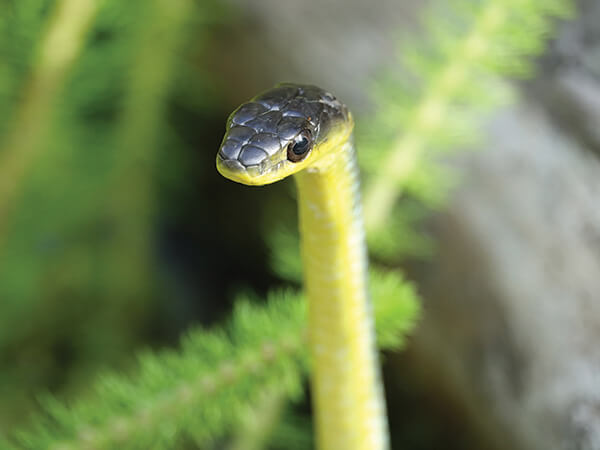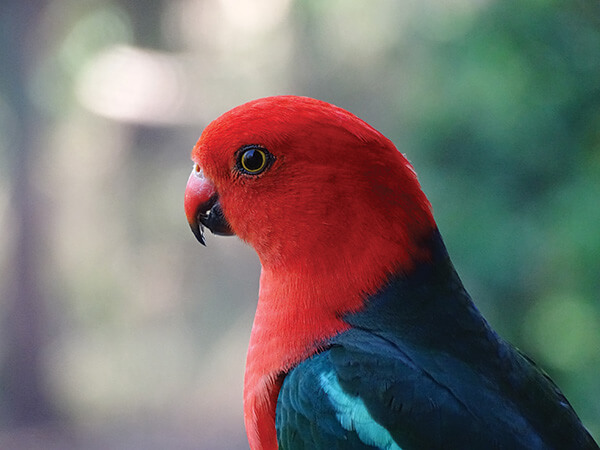If we’re smart, we never stop learning. It seems that with every new hobby, sport or interest we take up, we are reminded of how little we actually know about things. When Jo and I moved onto our little triangle of land five years ago, we possessed an odd mix of big expectations and little knowledge. But that didn’t stop us. We leapt into habitat rehabilitation with both eyes closed and our hearts wide open.
The sheer diversity of life on our little oasis is stunning. We are regularly visited by more than 90 different species, including Glossy Black-Cockatoos and an incredible variety of frogs. When we first heard the mating Koalas outside our bedroom window, we thought we had somehow stepped into a sci-fi horror movie. Now we know what animal makes that sound – something between a pig’s oink and a donkey’s bray – it’s music to our ears, and something we very much look forward to.
I would list the birds that we have seen over the past few years, but frankly, it would take up too much space. Honeyeaters, finches, parrots, doves, pigeons and raptors all make daily appearances. And where there are birds and frogs, you’ll naturally find snakes. We regularly garden with them. Little brownies (and some not so little), Red-bellied Black and Green Tree Snakes, Yellow-faced Whips and our beloved pythons, who often make themselves at home on the verandah.
With clearing on surrounding properties becoming an issue, we pledged to provide our wild friends with something better, and that was where the learning really started.
We had relocated from Brisbane’s inner suburbs, where weeds were something you squashed with the toe of your shoe, to Ocean View, where the weeds had experience with combat, and were prepared to take no prisoners. Our first attempts at clearing a few Lantana plants resulted in hundreds of new shoots, which regrew from the stems that we had discarded in the dirt. We poked eyes, tore clothing and scraped our arms to the point that friends began to question our sanity.
We still have not beaten the Lantana back, choosing instead to remove it bit by bit, and to retain the pioneer species that are loitering beneath it, just waiting for their chance at the sunshine. It’s a slow process, made even slower by the rate at which the weeds grow after rain, and perhaps by the fact that, each and every year, we get a little older and a little slower.
Our planting regime was similarly disorganised at the start. We came to the property with 400 trees in pots, and foolishly began planting them in every corner of the property, which doubled the work needed to keep them watered and maintained. By the time we had 1200 plants in the ground, we had begun to get wise, and these days we choose a specific area, we clear it, we plant it and we water it until we can move on to the next.
We made mistakes with the most basic ingredient: dirt. Initially, we were able to get hold of some composted goat’s poo, and it turned out to be an excellent planting medium. But when that ran out, we discovered what we thought would be the answer to our prayers: coir blocks. Yes, they were expensive (~$1000 spent), but the thought of a juicy, organic ‘growing medium’ sustaining our trees through the dry times was just too much to pass up.
We set about planting everything in a half and half mix of coir and soil, our first project being 40 Lemon-scented Tea-trees that were to become our living fence. The trees were six inches high when we planted them, and now, four years later, they are around a foot high. Disappointing. Every tree that got the coir treatment has performed less than satisfactorily, with many simply falling over, as their roots find no purchase during windy weather. It seems that the coir, when it dries out, reverts back to its original, coconut-fur state. Trees don’t like it, so neither do we.
I’m sure many readers know about the challenges of gardening on a steep slope. With most of our land at a 15% gradient, the gardening day often feels like a crossfit workout, particularly when we are wearing our ‘anti-tick’ armour and heavy, snake-bite proof boots in the middle of summer. We often joke that we must be more than a little mad.
So why? Why do we do it, given the challenges and disappointments that we face on our journey? You know as well as I do. The answer is right outside your door, and mine. It’s there after every spring rain, when the tips of the trees and bushes burst forth with their bright green or ruby-red new growth. It’s there in the flowers on the grevillea that drip with tasty nectar and have the New Holland Honeyeaters swarming from dawn to dusk. It’s the sound of thousands upon thousands of bees enjoying the Tallowwood flowers, high above you. It’s the resident wallabies who, once they’ve finished ‘pruning’ your shrubs for you, will lounge back on the grass and enjoy the afternoon shade from those flame trees or Davidsons Plums that you planted a few years back.
The answer is this: it is the unrivalled joy that you feel when you stand on your land, look around you and realise that the world has been made a better place thanks to your efforts.
It’s a labour of love, quite simply, and what a labour. But what a love.
Article and photos by Andy McLean
Land for Wildlife member
Ocean View, Moreton Bay
View Full Newsletter


